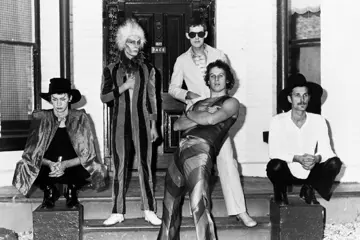HAIL, CAESAR!

The genesis of Hail, Caesar! traces back to a recurring joke that George Clooney, that charming cad, would trot out in interviews: this the supposed title of his next project, another collaboration with the ever-brilliant Coen Brothers. Gorgeous George’s gag being, of course, that there was no such project on the horizon. Eventually, the Coens — always up for a lark — decided to call Clooney’s bluff: writing a picture that would again cast him as a vain, ridiculous lead in a screwball comedy; completing — after 2000’s O Brother, Where Art Thou? and 2003’s Intolerable Cruelty — what the brothers are calling their ‘Numbskull Trilogy’.
Given that genesis, its not so surprising that Hail, Caesar! feels like a lesser Coen Brothers film, a daffy shrine to Old Hollywood whose vast array of oddball characters and circuitous storytelling feels better suited to a series. There’s no real emotional through-line to the plot, no hook for an audience, no sense of mounting tension. It marks a day — and a dark night of the soul — in the life of Josh Brolin’s studio fixer, who struts about the backlots and sound-stages of Capitol Studios, in 1951, making sure things keep running smooth: greasing the wheels, stoking the boiler, putting out fires, placating egos.
Clooney is starring in a biblical epic called, also, Hail, Caesar!, the film within a film, a prestige picture, that the studio is hoping will reap huge returns. But, mid-first-act, he’s drugged, kidnapped, and held for ransom by a benign cadre of Communist screenwriters (whose ranks are verily stuffed with oddball character actors, from Fred Melamed to Patrick Fischler to David Krumholz). This is, essentially, the drama at Hail, Caesar!’s centre, but it’s the least-dramatic kidnapping imaginable. Rather than playing the undercurrent of crime for thrills, the Coens are more interested in dancing giddily through the plurality of the studio system, and in lovingly recreating a host of dusty genres.
So, there’s a film-stealing Alden Ehrenreich, a horse-and-lasso stuntman turned singin’ cowboy who stars in cheap, profitable oaters. There’s Scarlett Johansson as the tough-talking East Coast broad brought out West to smile her way through synchronised swimming sequences in ‘aquatic ballet’ pictures. There’s Channing Tatum, the light-in-his-loafers song-and-dance man going all out for a showstopping, toe-tapping number in a sailors-on-shore musical. And there’s Ralph Fiennes, English theatre toff turned ‘serious drama’ director, midway through making the comedy-of-manners Merrily We Dance.
"The Coens can barely contain their glee as they bring old-world Hollywood back to life, with a mix of authenticity and their own strange style."
Don't miss a beat with our FREE daily newsletter
The Coens can barely contain their glee as they bring old-world Hollywood back to life, with a mix of authenticity and their own strange style. And, that glee can rub off: the outlandish choreography in Tatum’s musical sequence is, alone, worth the price of admission. So, too, are the moments of idiosyncratic, absurdist, Coenist humour a delight: like when we head into the dingy bowls of Frances McDormand’s editing suite, or ricochet between twin, rival gossip columnists, played by Tilda Swinton as all snide remark, ridiculous hat, and lively neuroses.
Yet, for all its charm, its moments of intermittent genius, Hail, Caesar! never quite coheres into something singular; Brolin never becoming a hero worthy of, say, Billy Bob Thornton’s lead turn in the noir-riff The Man Who Wasn’t There. In that film, his central narration showcased the Coens’ pitch-perfect ear for dated lingua, but, here, the sparsely-used narration comes from Michael Gambon, whose ironic delivery of portentous bluster effectively serves to diminish the material; not bringing together its scattered plot, but keeping the film feeling episodic, odd.
TRUMBO

Like Hail, Ceasar!, Trumbo throws itself into Communist hysteria in the Golden Age of the Hollywood studio system. And, it even casts old Coen Bros stand-bys John Goodman and Stephen Root as the B-movie King Brothers, and A Serious Man lead Michael Stuhlbarg as the saddest Edward G. Robinson you’ve ever seen. But any hopes for Coen-esque satire or strangeness being employed to enliven this workmanlike, heroising portrait of Blacklisted screenwriter Dalton Trumbo don’t, sadly, come to fruition.
Instead, director Jay Roach — yes, the guy behind Austin Powers and Meet The Fockers — essentially mounts a glossy telemovie, it only the top-shelf cast that distracts you from the unambitious mediocrity at play. And, well, that cast is pretty swell: Bryan Cranston doing sterling, snarling work as the glib, bon-mot-spouting lead; the incomparable actor-of-her-generation Elle Fanning showing up halfway through as his grown-up daughter; Louis C.K. a world-weary, cancer-stricken chainsmoker who serves, unexpectedly, as the film’s contrary voice of conscience. Even the thankless concerned-wife role has Diane Lane, making something out of nothing.
"Roach happily serves up all manner of era clichés: jaunty jazz, clacking typewriters, popped benzadrine, ’50s suburbia as nightmare of white-flight paranoia."
Roach, however, happily serves up all manner of era clichés: jaunty jazz, clacking typewriters, popped benzadrine, ’50s suburbia as nightmare of white-flight paranoia. But, moreso, he parades a celebrity currency that flatters Hollywood even whilst dramatising its darkest hours. John Wayne (David James Elliott) may be depicted as meathead patriot, and Hedda Hopper (Helen Mirren) as racist muckraker, but you can feel the sense of delight every time John McNamara’s so-so script name-drops Stanley Kubrick or has a character walk on-screen and say something all-too-literal out loud like “I am Otto Preminger!”
What Roach does best, probably, is recreate the look-and-feel of old newsreels; splicing his actors into scenes with real life historical figures. That, of course, symbolises the limits of Trumbo, which feels more like an act of old-Hollywood dress-ups than a profound portrait of a man remaining true to his beliefs —and eloquent in expressing them— even in the face of great personal detriment.
The film culminates with Trumbo’s 1970 speech upon receiving a lifetime achievement award; which is, not coincidentally, the same way that the 2007 documentary Trumbo did. In that film, Peter Askin had actors read from Trumbo’s real-life letters; the most beautiful, personal of which were penned to his daughter. Whilst there was just as much artifice in that presentation, there was also more of a sense of truth, and of who its subject really was.
45 YEARS

In the best scene in 45 Years — and in one of the better scenes you’ll see in a cinema all year — Charlotte Rampling ascends the pull-down stairs into the attic of the house she’s spent a lifetime in with husband Tom Courtenay. The couple are preparing for the celebration of their 45th anniversary on the coming weekend, but unexpected news has caused them to be distracted, and called into question what this half-century together has really meant.
"It’s a work in which silence is the central dramatic device."
Early in the week, Courtenay receives a letter from Switzerland, telling him that the German lover he lost 50 years before, in a tragic accident whilst hiking in the Alps, has been found, entombed for all this time — frozen, preserved — in a glacier. Shaken by the news, and drawn back into a distant past he’d long forgotten, Courtenay has been spending increasing time up in the attic, looking mournfully through the few mementos he’s still kept of his time with this long-distant love.
When Rampling ascends the stairs — dog barking, ominously, at her actions — there’s almost shades of Hitchcock; she rising, ill-advised, into the unknown, tranquil lives about to be shattered. What she finds is a dirty projector, loaded with a carousel full of slides; the story of Courtney’s life Before Them writ in sunkissed pictures. We watch her cycling through the images, scene silent but for the projector’s whir and clunk, revelation coming wordlessly; Rampling’s graceful, ageless face betraying a complex, roiling sea of internal emotions.
It’s a sequence the greatness of director Andrew Haigh; the way he can combine true naturalism — real locations, no score, ambient sound, human vulnerability — into moments profound, somehow pure. With his breakout second feature, 2011’s Weekend, and his unfalteringly-good TV series Looking, Haigh became known both as queer filmmaker, and writer/director adept at navigating the loaded complexities of contemporary conversation.
45 Years shows that Haigh’s skills go far beyond that. It’s a work in which silence is the central dramatic device. A couple five decades deep into a relationship have an unspoken communication, sure, but those loaded silences are ripe with all the things they’ve never said, all the secrets they’ve never shared.
SON OF SAUL

In Son Of Saul, his sterling, breakout debut, director László Nemes positions his camera behind the head of his eponymous lead (Géza Röhrig), following him about the place he lives, works, and will likely die: a German extermination camp in 1944. There, he’s a sonderkommando, an indentured servant of the Reich kept alive only to perform the most degrading acts of Final Solution; his job, in this most horrifying of factory models, to take freshly-gassed corpses to the crematorium.
"Is this a triumph of humanity in the face of inhumanity, or an act of single-minded idiocy?"
Nemes’ depiction of death-camp life ricochets between domestic banality and a searing vision of an unimaginable hell. With an eye for vivid visuals, the director creates a host of unforgettable images: first we see bodies being burnt in mass piles, then we see their ashes being shovelled, from trucks, into a nearby lake. These images come, often, with the one fixed perspective. As we follow Röhrig — in unbroken shots that create less of the languor familiar to long-take cinema, more a sense of mounting agitation and smothering claustrophobia — that behind-the-head shot has all manner of visual evocations, from video-games to Gus van Sant’s Gerry to the cinema of Nemes’ countryman, Béla Tarr.
But the best comparison is the Dardenne brothers. Not just in Son Of Saul’s long, repetitious shots, tagging along after its protagonist in cloistered, dispiriting environs, but in the way its titular character, victim of oppression and desperate survival, stalks through his lamentable world like an animal. When, amongst the bodies, Röhrig find a corpse he believes to be his long-unseen biological son, he becomes obsessed with the idea of finding a rabbi amongst the interned, and giving him a proper Jewish funeral. As he endangers himself and his fellow inmates in this pursuit, Son Of Saul leaves open, and unanswered, its central question: is this a triumph of humanity in the face of inhumanity, or an act of single-minded idiocy?
CONCUSSION

If Concussion had a more daring script, a more accomplished filmmaker at the helm, or a better Nigerian accent from Will Smith, it might really be something else. Instead it’s just something, a solid, workmanlike, uninspired prestige picture that wastes the mother of all villains — the NFL, essentially the Republican Party as sports league — in its inspirational whistleblowery. It’s, to directly quote our old pal Wikipedia, a ‘biographical sports medical drama film’, which feels like about three words too many. Especially when one — Oscarbait — would do.
"Concussion suffers by dint of a playing-it-safe approach that delivers conservative writing and uninspired photography."
It’s a portrait of Bennet Omalu, the forensic pathologist whose pioneering autopsy research on the corpses of recently-deceased tackle-football players reveals a recurring pattern of traumatic brain injuries; a career of helmet-on-helmet collisions leading to a degenerative condition called CTE. The themes, in such, are rich: it taking an immigrant to take on the biggest sport in the land; the NFL another All-American institution involving wealthy white men making filthy lucre from the suffering of a largely-black workforce; and corporate might/money dictating everything from medical research to public policy and public-relations.
There’s some nice touches herein — mostly from a superbly-complex, prickly performance by Albert Brooks, but also in the way that Roger Goodell, human buffoon, is played by Luke Wilson — but, ultimately, Concussion suffers by dint of a playing-it-safe approach that delivers conservative writing and uninspired photography, and an almost unbearable earnestness embodied by its star. Here, Smith’s mannered performance isn’t a work of transformation, but a transparent attempt to make a ‘serious’, award-show-worthy career-turn.















